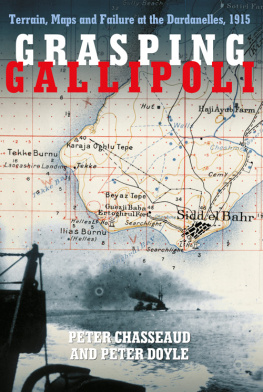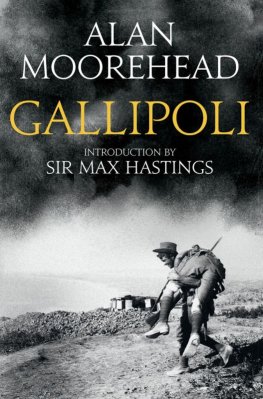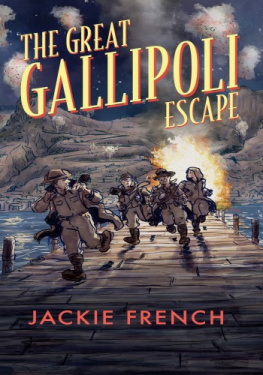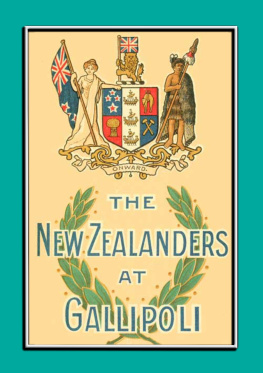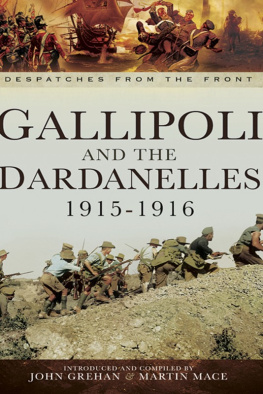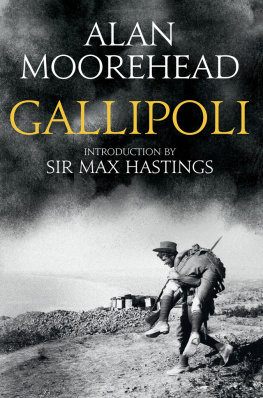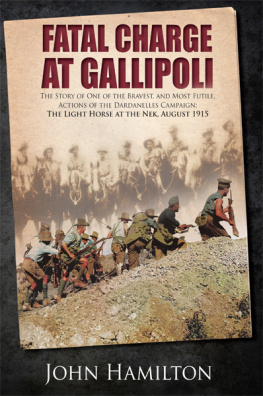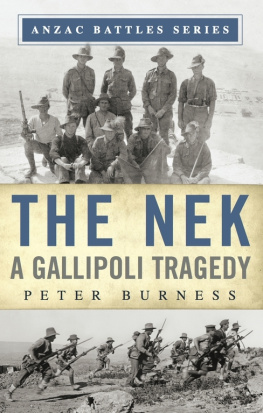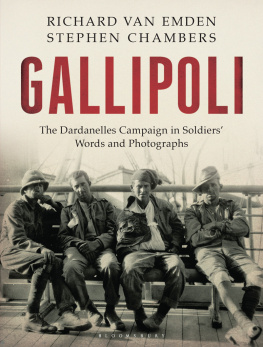
We would like to acknowledge the very generous assistance and advice given by Dr Ian Mumford, and the excellent pioneering articles by Col. Mike Nolan RE (retd) on Gallipoli mapping which appeared in The Gallipolian in 19935 and have been extremely useful. The exhaustive work by the late Jim Tolson on sorting and listing the maps which were subsequently transferred to the Public Record Office (now the National Archives) should here be commemorated, and the thorough compilation of details of Gallipoli maps in the Australian War Memorial collection, undertaken by John Bullen, should also be recorded.
Particular thanks are accorded to the courteous and helpful staff of the National Archives (Public Record Office) at Kew, the source of a large number of the maps and documents consulted during the research for this book. Several of the photographs are reproduced with kind permission of the Trustees of the Royal Engineers Museum, Chatham. Thanks are also given to the following for their various forms of assistance: the staff of the Imperial War Museum at Lambeth, the British Library, the Admiralty Library, RUSI Library, the Royal Engineers Institution Library and Museum at Chatham, HM Hydrographic Office at Taunton, Keith Atkinson MBE, Prof. H-K Meier, Dr Andrew Cook, Francis Herbert and David McNeill of the RGS Map Room, Peter Jones and the staff of the Defence Geographic Centre, DGIA, Anne-Marie de Villle and Claude Ponou of the Service Historique de lArme de Terre at Vincennes (Paris), Nigel Steel, Peter Barton, Matthew Bennett, Sarah Nicholas, Adrian Webb, Jenny Wraight, Dave Parry, Kenan Celik and Bill Sellars. Thanks are also due to Gill Dowson for allowing us to reproduce in Appendix VII the hitherto unknown report by Ernest Dowson on his visit to Gallipoli in July 1915.
Notes
. Nolan (19935).
Contents
Appendices: |
I |
II |
III |
IV |
V |
VI |
VII |
Admiralty | Government Department dealing with Naval administration, also containing Naval Staff |
ANZAC | Australian and New Zealand Army Corps |
AWS | Admiralty War Staff, London |
Battery | Set of guns or howitzers under a single command and control |
BEF | British Expeditionary Force (France and Belgium) |
CID | Committee for Imperial Defence (London) |
CIGS | Chief of the Imperial General Staff (London) |
C in C | Commander in Chief |
DAQMG | Deputy Assistant Quarter-Master General (a Staff Officer) |
Dardanelles Commission | Enquiry set up by Asquith in 1915 to investigate the Gallipoli fiasco |
DMO | Director of Military Operations (and Intelligence) |
First Lord of the Admiralty | Political head of the Navy, a Cabinet Minister |
First Sea Lord | Professional head of the Navy, the senior Naval officer |
FO | Foreign Office, London |
GHQ, Egypt | Maxwells Headquarters |
GHQ, MEF | General Headquarters, Mediterranean Expeditionary Force |
GOC | General Officer Commanding |
GSGS | Geographical Section of the General Staff (MO4), War Office, London |
HUMINT | Human Intelligence |
IMINT | Imagery Intelligence (Aerial Photography in 191418) |
MEF | Mediterranean Expeditionary Force (Hamiltons Force) |
MG | Machine Gun |
MI | Military Intelligence (War Office; in 191415 MO) |
MO | Directorate of Military Operations and Intelligence at War Office (split at end of 1915) |
NID | Naval Intelligence Division, Admiralty, London |
OS | Ordnance Survey, Southampton |
Photogrammetry | Science of accurate plotting of points and lines (mapping) from aerial photos |
Porte | La Sublime Porte : the Ottoman Court at Constantinople; the Turkish Government |
psc | Passed Staff College; a professionally trained staff officer who had passed through the Staff College at Camberley |
RNAS | Royal Naval Air Service |
RND | Royal Naval Division |
RNVR | Royal Naval Volunteer Reserve |
SIGINT | Signals Intelligence |
TOPINT | Topographical Intelligence |
War Council | Cabinet Committee, including Chiefs of Staff, dealing with strategic direction of war |
War Office/WO | Government Department in London dealing with Army administration, also containing General Staff |
Home to Ardagh, Constantinople, 19 November 1876, speaking of the Crimean War [TNA(PRO) WO 33/29, Reports & Memoranda Constantinople & Roumelia 1877, pp 501, No. 7].
The Government of the day, in the early stages, never seemed to know what they really wanted. Their orders were ambiguous, and that ambiguity was carried through every department of the army, and resulted in half-measures a desire to do what would suit two distinct lines of policy.
When disasters seemed to threaten, there followed an excited, feverish action, striving by lavish expenditure to recover lost time and make up for previous parsimony; this expenditure benefitted the army but slightly, while a host of civilians, vice-consuls and Levantines of all shades, fattened on it.
Urged by the Press and eager to do something, the War Office fell a prey to inventors amateur soldiers, amateur engineers. The old and tried servants were put to one side, or compelled to carry out the whims and ideas of men whose notions of war were derived from the columns of our own correspondent.
Reading the mass of papers connected with the Crimean War of a confidential nature that have passed through my hands in my official capacity, I have been perfectly astonished at the extraordinary proposals gravely made in England by these amateurs, and as gravely submitted to the chiefs of the army in the field for report.
The Gallipoli Campaign of AprilDecember 1915 the Allied landings on the shores of Turkey has been the subject of a vast literature, which has most unfortunately propagated a great untruth that the War Office was unprepared for operations in the Dardanelles area, and had little or nothing in the way of maps and geographical intelligence to give to Sir Ian Hamilton, the commander of the Mediterranean Expeditionary Force (Medforce), and his Staff. First explored in Aspinall-Oglanders Official History, Yet the reality is somewhat different, and this book demonstrates that this myth, perpetrated by Hamilton himself among others, is a gross distortion of the truth. While there were problems in London with strategic policy and planning (or lack of it) at the highest level, the War Office (and the Admiralty) possessed a great deal of previously collected terrain information, maps and charts, covering the topography and defences of Gallipoli and the Dardanelles, much of which was duly handed over to Hamilton and his Staff, either before they left London or subsequently. Additional material was obtained from the Admiralty and Navy, and still more gathered in theatre, in the Aegean and the Levant before the landings.
Next page
